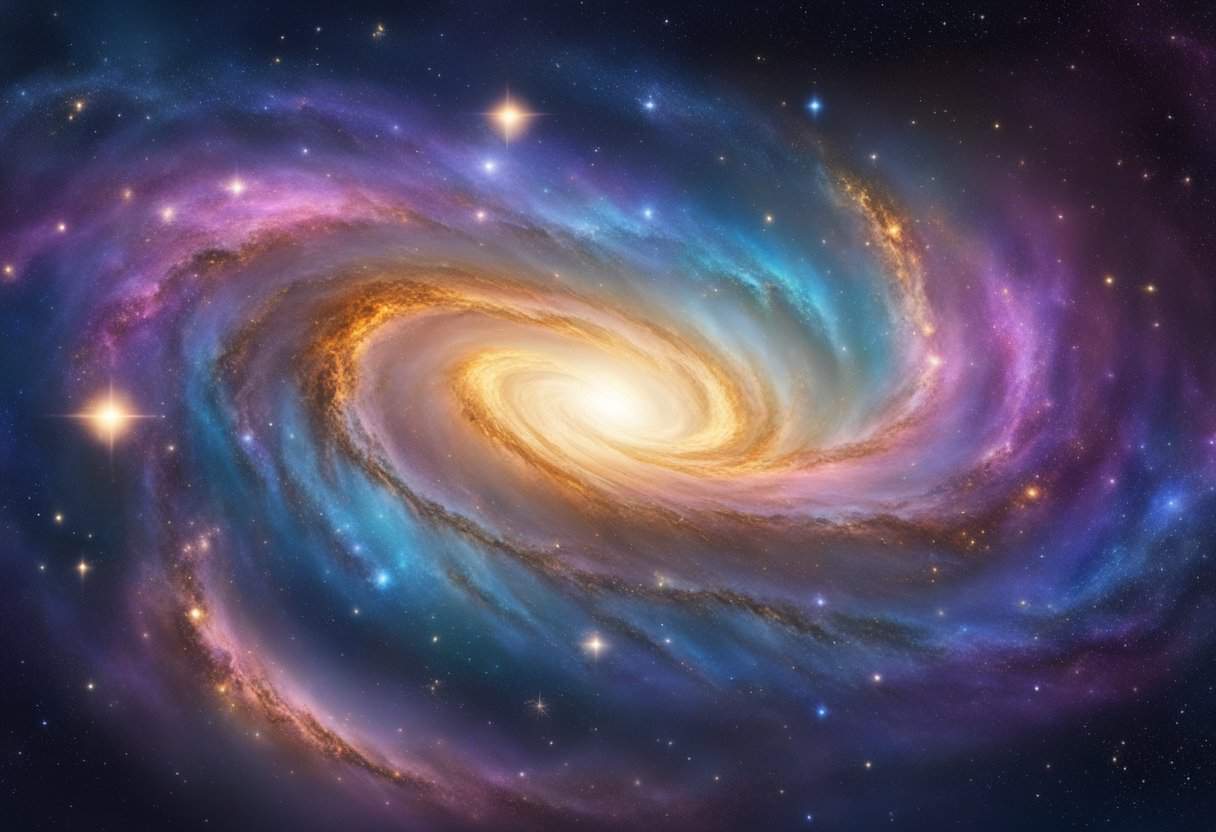Galaxies are the grand structures of the cosmos, each with distinctive traits that make them a spectacle in the night sky.
When discussing the best looking galaxies, it’s important to consider the characteristics that contribute to their visual appeal. Spiral galaxies, such as the iconic Andromeda or the Whirlpool Galaxy, present with magnificent arms wrapping around their luminous cores, creating a celestial show that captures the imagination.
On the other hand, elliptical galaxies offer a different type of beauty with their smooth, featureless light profile that spans across vast spaces, painting the sky with a serene glow. Each galaxy type, whether it’s spiral, elliptical, or the less common irregular galaxies, brings a unique aesthetic to the tapestry of the universe.
The majestic appearance of these celestial bodies is further enhanced by phenomena such as galactic collisions, which reshape galaxies into intriguing, often temporary, masterpieces of natural art.
Spiral galaxies, like Andromeda and the Whirlpool Galaxy, dazzle with their luminous cores and ornate arms. Elliptical galaxies, in contrast, charm with their serene glow and expansive light. The universe’s beauty is further enhanced by dynamic galactic events, such as collisions, creating temporary, awe-inspiring art.
The Splendor of Spiral Galaxies

Spiral galaxies are among the most visually striking objects in the universe, with their swirling arms and bright cores. They offer a glimpse into the vastness of the cosmos and the complexity of galactic structures.
The Milky Way
Your home galaxy, the Milky Way, is a classic example of a spiral galaxy. Its disk spans about 100,000 light-years in diameter, with a distinct bulging center enveloped by whirling arms that are home to billions of stars. Observations reveal a great splendor in the variety and structure of objects within it, from star clusters to nebulae, all interacting and orbiting the dense core.
Andromeda
Andromeda, also known as M31, is our spiral neighbor, and it’s on course to collide with the Milky Way in about 4 billion years. It’s larger than your galaxy, containing approximately one trillion stars. Through telescopes, you can see the Andromeda galaxy’s bright nucleus and spiral arms stretching across its 220,000-light-year diameter.
Whirlpool Galaxy
The Whirlpool Galaxy, known as M51, is another magnificent example of a spiral galaxy. It’s a grand design spiral, notable for its well-defined structure with prominent arms. Here, you can observe the creation of new stars in the pinkish knots of its arms, indicative of energetic star formation. M51 is interacting with a smaller galaxy, NGC 5195, showcasing how gravitational forces shape the universe.
Elliptical Elegance in the Cosmos
When you gaze upon the night sky, among the most visually striking objects are the elliptical galaxies. Known for their smooth, featureless light profiles and nearly spherical shapes, they exude a uniformity and symmetry that can be described as an elegant simplicity within the cosmos.
M87
One of the largest and most massive galaxies in the nearby universe, M87, harbors a supermassive black hole at its core. Your understanding of galaxy dynamics is enriched by the detailed observations of this galactic giant’s jet, which provides concrete evidence of the energetic processes at the heart of such massive elliptical galaxies.
Centaurus A
You’ll find Centaurus A to be a peculiar example, showcasing a unique dust lane bisecting its elliptical brightness. It represents a narrative of galactic evolution and interaction, hinting at its violent past of galaxy mergers. This cosmic collision has sculpted Centaurus A into the iconic figure you recognize in the deep sky, revealing the underlying complex structure within these seemingly simple systems.
Irregular Galaxies and Their Unique Appeal
Irregular galaxies, such as the Large and Small Magellanic Clouds, stand out in the cosmos due to their atypical structures and rich history. You’ll find that these galaxies do not conform to the traditional spiral or elliptical shapes.
Large Magellanic Cloud
The Large Magellanic Cloud (LMC) is a satellite galaxy of the Milky Way. You can appreciate its visibility in the southern hemisphere night sky, where it is distinguished by its apparent brightness and proximity to Earth. It’s an atypical irregular galaxy and is notable for its well-studied Tarantula Nebula, which is one of the most luminous and high-energy regions within the local group of galaxies. Researchers have been particularly interested in the LMC’s role in galaxy evolution, given its unique structure and the presence of dark matter.
Small Magellanic Cloud
Just like its larger counterpart, the Small Magellanic Cloud (SMC) is a satellite galaxy of our Milky Way. You’ll find it also in the southern sky, slightly fainter and farther away than the LMC. The SMC is fascinating because of its dynamic interaction with the LMC and the Milky Way, creating a bridge of gas known as the Magellanic Stream. This interaction showcases the complexity involved in the gravitational relationships between galaxies.
Galactic Collisions and Their Stunning Aftermath
When you gaze up at the night sky, the peaceful twinkling of stars belies the dynamic and sometimes violent nature of the universe. One of the most dramatic events in the cosmos is the collision of galaxies. Far from destructive endgames, these astronomical clashes can create some of the most visually striking structures in the universe.
Galactic collisions are not rare; in fact, due to gravity, galaxies often approach one another, and these meetings can lead to several outcomes. A fascinating example of such an event is the creation of ring galaxies. This occurs when one galaxy passes directly through the core of another, sending ripples outward that trigger intense star formation in a symmetrical ring.
Here’s a glance at what you can expect from these cosmic encounters:
- Starbursts: Regions of exceptionally active star formation, creating a radiant visual spectacle.
- Galactic Mergers: Over time, colliding galaxies may merge, blending their stars and gas to form new, often elliptical galaxies.
- Tidal Tails: Long streams of stars and gas pulled from the outer regions of galaxies, stretching out into space like cosmic tethers.
These interactions, while spread out over millions of years, have profound implications for the future shape and evolution of the constituent galaxies. Despite the potential for new star formation, actual star collisions are, surprisingly, rare due to the vast interstellar distances.
Your appreciation for these astronomical phenomena can grow by exploring further into the transformations they induce. For a deeper understanding, consider delving into the works like “Galaxy Collisions: forging new worlds from cosmic crashes” where the graceful dance of gravitationally interacting galaxies is examined.
The Role of Color and Light in Galaxy Aesthetics
Colors in images of galaxies play an essential role in how you perceive and appreciate their beauty. These colors are not just aesthetic choices but are often used to convey scientific information. When astronomers create images of galaxies, they use different processes to assign colors, sometimes selecting hues that represent real optical colors, and other times choosing colors to highlight features invisible to the naked eye.
Your understanding of a galaxy’s aesthetics is influenced by the interplay of light and color. In images, colors can emphasize certain elements like the age of stars or the distribution of gases. For instance, older, cooler stars may be represented in shades of red, while younger, hotter stars might appear blue or white.
Images that use “true color” aim to replicate what your eye might see if the objects were much brighter and closer to Earth. However, many celestial images also incorporate colors based on wavelengths of light beyond human vision, translated into the visual spectrum to reveal hidden structures. This practice, known as false color, can make features like the swirls of a galaxy or the jets of a black hole stand out more prominently.
Remember, the colors in astronomical images also depend on the sensitivity of the instruments capturing the light. Advanced telescopes can detect light across various wavelengths, from radio to gamma rays—each potentially mapped to a color that helps in analyzing the celestial body’s composition and activity.
Here’s a quick reference for understanding color use in galaxy imagery:
- True Color: Aims to mimic human vision.
- False Color: Enhances specific wavelengths to reveal hidden details.
- Intensity Mapping: Assigns brightness levels to different colors.
Your appreciation of galaxies is thus a blend of both their inherent beauty and the techniques used to visually enhance and study them.
Frequently Asked Questions
Galaxies grace the cosmos with their intricate structures and vibrant colors. This section answers common inquiries about the most breathtaking galaxies that adorn our universe.
What are the names of some of the most visually stunning galaxies?
The Andromeda Galaxy, the Whirlpool Galaxy, and the Antennae Galaxies are known for their captivating beauty. These celestial structures showcase remarkable patterns and luminosity.
What galaxy is considered the most beautiful by astronomers?
Often cited for its splendor, the Sombrero Galaxy stands out with its bright nucleus and prominent dust lane, resembling a sombrero hat.
Can you list examples of spiral galaxies known for their impressive appearance?
The iconic Spiral Galaxy M51, also known as the Whirlpool Galaxy; M81, with its defined arms; and the grand design Spiral Galaxy M74, are acclaimed for their distinctive and impressive spiral structures.
Which galaxy has been called the most unique in terms of structure and visuals?
The Hoag’s Object, with its ring-like appearance surrounding a near-perfect circular core, is often highlighted for its uncommon and unique structure.
What are the rarest galaxy shapes observed in the universe?
Some of the rarest shapes include ring galaxies like the Hoag’s Object and the peculiar and unique irregular galaxies, such as the Large Magellanic Cloud.
Where can one find images of the most magnificent galaxies?
Images of breathtaking galaxies are accessible through resources such as NASA’s Hubble Space Telescope galleries or the European Space Agency’s cosmic image archives.


![SoloMark Telescope 700mm Review [year]](https://observationhobbies.com/wp-content/uploads/2024/01/Telescopes-for-Adults-768x525.png)
![Best Smartphone Telescope Adapter: Top [year] Picks](https://observationhobbies.com/wp-content/uploads/2024/01/Best-Smartphone-Telescope-Adapter-768x525.png)


![Best Telescope for Solar Eclipse: Expert [year] Picks](https://observationhobbies.com/wp-content/uploads/2024/01/Best-Telescope-for-Solar-Eclipse-768x525.png)
